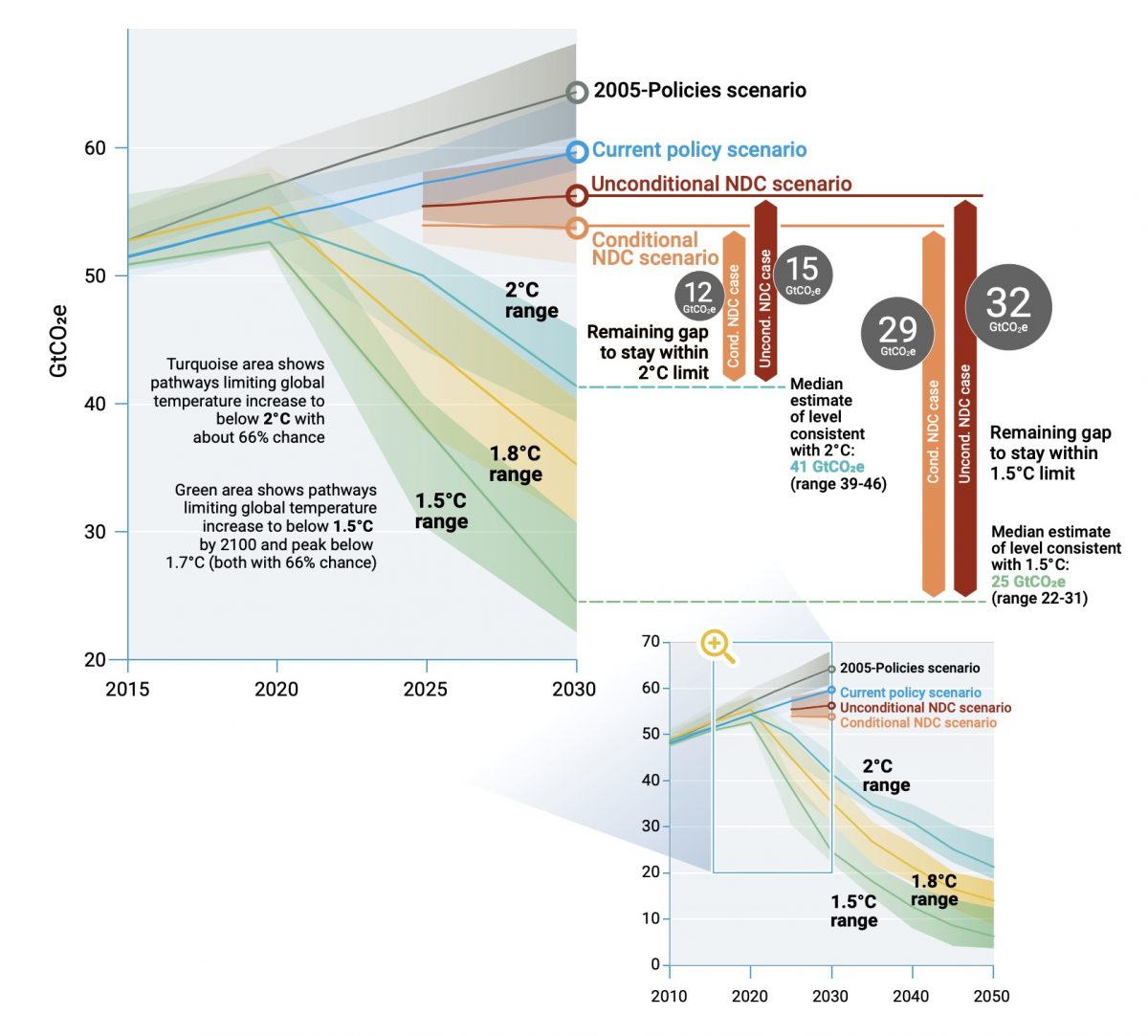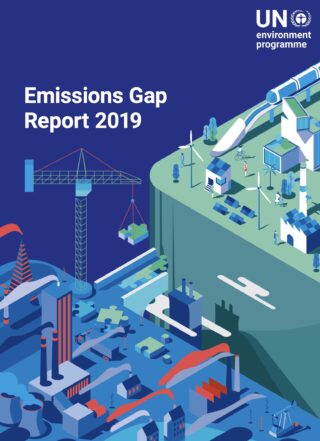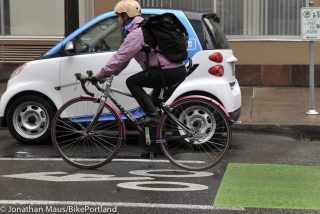Contributor Catie Gould is co-chair of Bike Loud PDX and is sort of obsessed with tracking climate change news.
I had plenty to digest over the Thanksgiving holiday, including an important new progress report on the global battle against climate change.
Last Tuesday the United Nations released its annual Emissions Gap Report. This annual report tracks country-level progress on Paris Climate Agreement goals, and outlines not just our failings (which there are many) but also potential pathways to decarbonization in which urban policy is a major player.
In hopes of spicing up my Thanksgiving table conversations, I read all 108 pages of the report. What I found was both interesting and depressing (of course).
First, some context about where we are.

Emissions are still rising at 1.5% per year and hit a record high of 55.3 gigatonnes of CO2 equivalent in 2018. With current policies, total emissions are expected to rise to 60 gigatons by 2030. To put that in perspective, to have a reasonable chance of limiting warming to 1.5 deg C, emissions need to be cut to 25 gigatons by 2030, which graphs out to 7.6% per year. The good authors of the report produced this charming graphic. Those little red and orange lines represent the Nationally Determined Contributions (NDC) that were agreed to in Paris. Even if those targets were met (they aren’t) the world would see 3.2degrees C by 2100. Those country level targets need to increase fivefold to be in line with the science.
Advertisement
The United States is still the worst
It shouldn’t be a surprise that the United States of America is not on track to meet its original targets, with the recent rollbacks in the Clean Power Plan and fuel economy standards. However, CO2 emissions have fallen by 14% between 2005 and 2017 despite a growing economy. The report also points to action at state and local levels including the U.S. Climate Alliance, which Governor Kate Brown is a part of.

Some good numbers
The report cites a growing body of research being done on the benefits of taking action. Analysis by the Global Commission on the Economy and Climate estimates that ambitious climate action could generate US$26 trillion in economic benefits between now and 2030 and create 65 million jobs by 2030, while avoiding 700,000 premature deaths from air pollution. A global fossil fuel phase-out could avoid over 3 million premature deaths each year from outdoor air pollution
Advertisement
“The word parking only appeared in the report once, and highways not at all.”
The Transportation challenge
Transportation sector emissions are growing more rapidly than emissions on average, at a rate of 2.5% annually between 2010 and 2015. Electrifying vehicles is expected to play a major part in this transition, with falling battery prices expected to achieve cost parity with internal combustion engines in the mid 2020s. Transportation today accounts for only 1% of global electricity demand, but could expand to 40% by 2050.
Recommended actions for transportation were:
– Compact urban planning Reducing passenger travel demand
– Shifting travel modes & public transit investment
– Electrification and improved fuel efficiency for vehicles
– Freight logistics
There was surprisingly little about modal shift besides this short passage, “…short journeys account for two thirds of transport emissions in urban areas and could be replaced by active modes. Electrification of the vehicle fleet alongside mass transit and micromobility can replace diesel and petrol cars, making cities more liveable with lower pollution levels.” The word parking only appeared in the report once, and highways not at all.
Advertisement
While we often think of transportation emissions as the hard stuff compared to decarbonizing the grid, the report cites that shipping and aviation, which make up 40% of transport emissions globally, will be significantly more challenging to decarbonize and electrify than road transport. The world’s largest shipping container company, Maersk, is working on a commercial carbon neutral vessel by 2030, and Scotland and Norway have targeted decarbonizing domestic flights by 2040 through electrification. Scotland is planning to trial low or zero emission flights beginning in 2021.
US gets call out for SUV use
The United States makes up 13% of global emissions, but represents 25% of all light duty vehicle emissions. It states, “In recent years, there has been a trend towards larger, heavier vehicles, such as sports-utility vehicles (SUVs) and pick-up trucks, which require more materials and higher operational energy use. Reducing the share of SUVs and light trucks in the United States of America from the current 53 per cent to 32 per cent by 2050 would reduce emissions from the production and operation of cars by 10 per cent.” Higher registration fees for higher emitting vehicles is one tool credited for incentivizing small vehicle sizes in some European countries.
Carpooling is better than Carsharing
Current trends project that the number of vehicles on Earth are expected to double by 2040. Yikes. The report talks through different scenarios for reducing cars, but not all are equal. The International Resource Panel estimated that having 25 per cent of drivers shift to car sharing would reduce emissions by 10 per cent, while shifting 25 per cent of trips to shared rides would reduce emissions by 20 per cent. Policies that discourage low occupancy car sharing are vital to reduce the number of cars such as congestion pricing or priority lanes for 3 or more occupants. Automated vehicles also have the potential for efficient car sharing but came with a strong warning, “If unregulated, such a trend will also likely increase driving distances which would impact emissions and may move people away from using more efficient public transport.”
Advertisement
Upzone your Neighborhood, Downsize your home
The report points out an encouraging trend towards smaller family sizes which can be leveraged into more efficient homes. Urbanized areas are also expected to grow from 55% of the global population today to 70% by 2050, and in general the report notes that urban and multifamily dwellings are smaller than suburban or rural ones. The International Resource Panel suggests that reducing floor space by 20 per cent per person could reduce the emissions associated with producing building materials for homes by 50–60 per cent by 2050. This seems easily accomplished given that US housing averages 68 square meters (732sq ft) per person, compared to the UK 34 square meters (344sq ft).
Taking advantage of these demographic shifts require both residents and neighborhoods to be nimble. “Policies that support homeownership may have the undesirable effect of subsidizing large residences through tax breaks and other measures. In some locations, spatial planning prevents the construction of multifamily residences and locks in suburban forms at high social and environmental costs.”
Social movements are needed
Interwoven through the technical chapters is a topic much harder to graph. These shifts are not just technical, but cultural and need strong social support to be successful. “Legitimacy for decarbonization therefore requires massive social mobilization and investments in social cohesion to avoid exclusion and resistance to change. Just and timely transitions towards sustainability need to be developed, taking into account the interests and rights of people vulnerable to the impacts of climate change, of people and regions where decarbonization requires structural adjustments, and of future generations.”
That last part strikes home for me. Beyond learning everything I can about the topic, being involved with transportation activism gives me strength to keep fighting.
— Catie Gould @Citizen_Cate on Twitter.
— Get our headlines delivered to your inbox.
— Support this independent community media outlet with a one-time contribution or monthly subscription.






